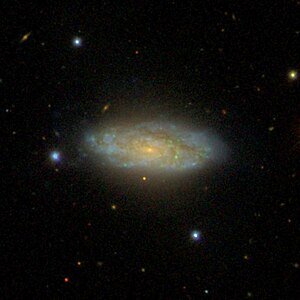NGC 3813
| Galaxy NGC 3813 |
|
|---|---|

|
|
| SDSS recording | |
| AladinLite | |
| Constellation | Big Bear |
|
Position equinox : J2000.0 , epoch : J2000.0 |
|
| Right ascension | 11 h 41 m 18.6 s |
| declination | + 36 ° 32 ′ 48 ″ |
| Appearance | |
| Morphological type | SA (rs) b |
| Brightness (visual) | 11.5 likes |
| Brightness (B-band) | 12.3 mag |
| Angular expansion | 2 ′ × 1 ′ |
| Position angle | 87 ° |
| Surface brightness | 12.1 mag / arcmin² |
| Physical data | |
| Redshift | 0.004888 ± 0.000017 |
| Radial velocity | (1465 ± 5) km / s |
|
Stroke distance v rad / H 0 |
(66 ± 5) x 10 6 ly (20.2 ± 1.4) Mpc |
| history | |
| discovery | William Herschel |
| Discovery date | April 28, 1785 |
| Catalog names | |
| NGC 3813 • UGC 6651 • PGC 36266 • CGCG 186-024 • MCG + 06-26-019 • 2MASX J11411865 + 3632481 • GC 2501 • H I 94 • h 945 • LDCE 0819 NED005 | |
NGC 3813 is a spiral galaxy of Hubble type Sb in the constellation Ursa Major. It is estimated to be 66 million light years from the Milky Way .
The object was discovered by Wilhelm Herschel on April 28, 1785 .
